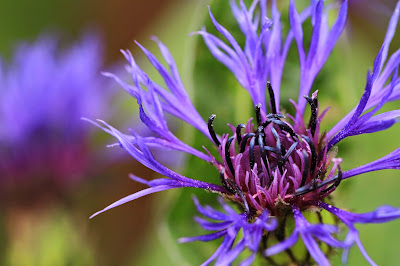Left: Five Small Vases of Spring Flowers; Right: Closeup of Borago, Corydalis, Heuchera, and Convallaria
It amazes us how many different types of flowers are in our postage stamp-sized yard, here in Seattle. In the list below, we leave out lavender, iris and many more. Many of the plants in the list have been in the yard long before we purchased the property. Links to pronunciation are given for family names.
[Asaparagaceae pron] Convallaria majalis - Lily of the Valley
This plant (like Coral Bells below) has been in our yard for at least 20 years, if not much longer. It hasn’t been prolific, but seems to carry on, year to year, and treat us to a few spikes of white, delicate sweet-smelling flowers.
[Asaparagaceae] Hyacinthoides hispanica – Spanish Bluebells
As pretty as these are, they are quite invasive. We seem to rip them up (bulbs and all) and there never is a shortage of them! Bluebells were here long before we bought the house and will be here long after we are gone!
[Asteraceae pron] Centaurea montana – Perennial Cornflower, Bachelor’s Button
Here’s another plant that we are not sure of its origin. C. montana has claimed a two by two square foot of our front yard, and that is fine by us. It will look lush for a few weeks, die out, and then return in the fall.
[Asteraceae] Leucanthemum vulgare – Ox-Eye Daisy
The white rays and yellow discs are pleasing to look at, but the smell of these flowers is not something that will want to make you cut them and bring them in the house often. As you can see here, we cut them early, hence no smell. This plant is another plant that came along with the house, oh so many years ago.
[Berberidaceae] Epimedium x versicolor 'Sulphureum' – Bicolor Epimedium, Bishop’s Hat
Finally, a plant we actually introduced into the yard! And a nice plant it is. We just have to remember to cut the old leaves off mid-Winter to be able to enjoy the delicate yellow flowers, which look like a bishop’s hat.
[Boraginaceae pron] Borago officinalis – Borage
Borage claims the areas in our yard where we don’t go that often, and we are okay with that, because in the deal we get pretty blue flowers which are edible and perfect in a salad or on top of a dessert.
[Cyperaceae pron] Carex pendula – Weeping Green Sedge
This sedge is quite hardy. It spreads easily and we remove many starts of it each year. A couple of catkin-like flower spikes from this sedge are pictured here.
[Cyperaceae] Carex morrowii
A couple of flower spikes from this sedge are in the arrangements.
[Juncaceae pron] Luzula nivea – Snowy Woodrush
In places where it’s hard to keep plants growing (like our median strip), this plant is quite happy to take over.
[Lamiaceae pron] Ajuga reptans – Bugle
We introduced this plant as ground cover many years ago and it did dismally. Later, after major landscaping and much moving around of dirt, it resurfaced on its own and found its niche in a couple of unobtrusive locations.
[Papaveraceae pron] Corydalis lutea – Yellow Corydalis
At one time, we planted this in one location in our yard, but now it has found its niche elsewhere, favoring cool, shady areas. The lacy leaves and little clusters of yellow flowers last a few months before the summer hits.
[Papaveraceae] Dicentra formosa – Western Bleeding Heart
We never planted Bleeding Heart, but its lacey foliage and delicate flowers show up faithfully on the margins of the yard. The generic name dicentra comes from the Greek dís "twice", kéntron "spur" referring to the shape of the flowers, which also look like little pink hearts.
[Saxifragaceae pron] Heuchera – Coral Bells
This plant has been in our yard for at least 20 years, if not much longer. Another, pre-Travelmarx yard plant. Its coral-colored flowers are a beautiful sight.
Left: Flowers in the Sample; Right: Flowers Annotated
Five Vases of Spring Flowers







No comments:
Post a Comment
All comments are moderated. If your comment doesn't appear right away, it was likely accepted. Check back in a day if you asked a question.